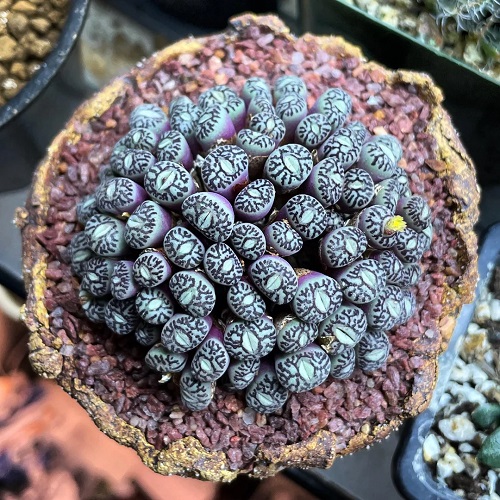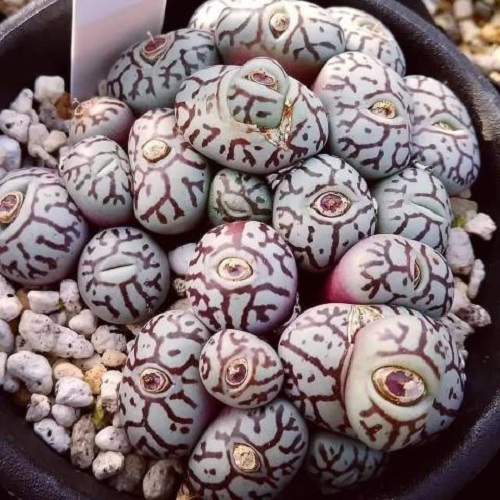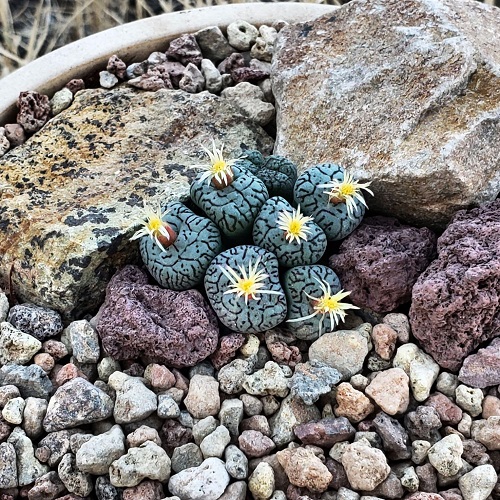All eyes will be on you if you grow this rare succulent that looks like human eyes! Learn how to care for Conophytum Wittebergense.

You may have heard of succulents that resemble pebbles, lips, the human heart, or even Shrek’s ears. Now, let’s funnel down to a rare Namibian and South African native that looks like human eyes and learn how to care for the Conophytum Wittebergense!
What is the Conophytum Wittebergense?

‘Wittebergense’ is an ecotype of the Conophytum minimum, also famously known as living pebbles. All its members resemble juicy round pebbles or glassy stones that jut out of the earth and form dense mats or cushions over time.
This variant appears as a silver-green round pebble with red to black bold spotting on its fleshy body. The best bit is a dimple at the center that opens up for fragrant nocturnal flowers in white, pale yellow, and pink.
As the flowers emerge, the central slit starts to widen, resembling human eyeballs—complete with streaks that look like capillaries around the white part. But we’ll leave it to your imagination to decide what this magical succulent reminds you of!
All we know is this: it’s a sweet little succulent that grows up to about three cm in height and width. And it needs all your love and care to survive and thrive outside its natural winter-raining habitat.
How to Grow Conophytum Wittebergense
Hardy to USDA zones 10-11, these bizarre and happily weird plants naturally grow during the winter rains common to their native habitat. Comprising fused pairs of leaves, conophytums divide easily and spread by forming colonies.
You can also propagate the plant via seeds, but doing it through offsets is much quicker. Flowering mainly in autumn, living pebbles can withstand winter drought but not summer’s dry heat.
Their growth cycle needs autumn and winter’s short, less bright days to sprout new life. And then, the arrival of summer marks dormancy or their “rest” period; during this time, they don’t grow much. Follow their summer-winter circle; you can grow and care for the unusual Conophytum Wittebergense anywhere!
Conophytum Wittebergense Care Tips
1. Not a Fan of Intense Direct Sun

Since these grow best in the winter rainfall areas of South Africa and southern Namibia, it’s clear they can’t survive arid, scorching sun and heat. Grow Conophytum Wittebergense in a greenhouse, on your patio, or by a sunny windowsill but slightly away to provide shelter from direct sun.
Just a few hours of harsh sun exposure for a few days can kill these delicate darlings. You can also use grow lights and adjust its intensity to grow and care for conophtyums indoors.
Another important thing to realize is while they prefer cooler ambiance, these succulents can’t tolerate frost and freezing temperatures and should not be kept below 40 F (5 C). Ideally, in winter, try to provide a temperature around 60 F (15 C).
2. Less Water, Little Problem

Again, we come back to “winter rains,” which mark their growing phase. Water deeply at this stage when your conophytums are pushing out new leaves, and repeat only once the soil has dried out between waterings.
The plant will get round and sturdy when its thirst is amply quenched and soft and wrinkly when it’s thirsty. However, this plant demands almost no water during dormancy—forgetful gardeners can celebrate!
3. Soil Conditions
Next, in Conophytum Wittebergense’s care routine, we look at its medium. Like most succulents, it prefers porous soil that has excellent soil drainage. It does not like being bound by packed soil.
Therefore, remember that proper aeration and water seepage are necessary to keep it in the pink of its health. You can soil you’d use for other conophytums or lithops species, apart from that, any cactus mix is suitable.
4. Supplements for the Peepers

Typically, succulents don’t need much fertilization. They do fine even if you don’t fertilize them ever! But like all anxious parents, a little happy feed may encourage better and more blooms.
Use a light, balanced, water-soluble fertilizer in a one-quarter dose of its recommended strength on the package just before the growing season, probably in early fall, and then fertilizer again in mid or late winter. Feeding once or twice a year is enough for these succulents.
Over-fertilization can lead to leaf scorch and kill your plant, so hold back on your temptation to overfeed your succulent babies.
5. Repotting your Conophytum

This plant needs repotting every 2-5 years, as it grows larger and its clusters spread. Go for a slightly bigger pot that is 4-8 inches wide once it starts pushing the circumference, and refill with a fresh, succulent potting mix.
Tip: If repotting, do so at the beginning of the growing season so the plant can adapt and heal quickly.


